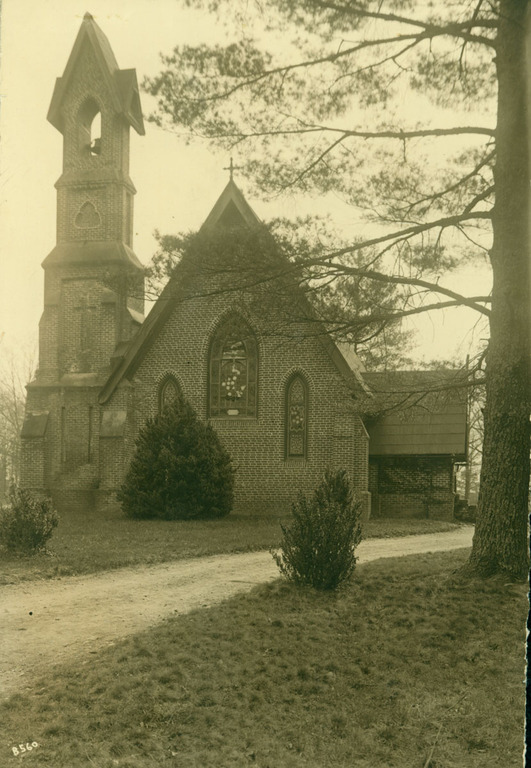Jones, Edward C. (1822-1902)
Birthplace:
Charleston, South Carolina, USA
Residences:
- Memphis, Tennessee
- Charleston, South Carolina
Trades:
- Architect
NC Work Locations:
Building Types:
Styles & Forms:
Gothic Revival; Italianate
Edward C. Jones (July 1, 1822-February 12, 1902) was a prolific and eclectic architect in Charleston, South Carolina, before the Civil War and in Memphis, Tennessee, after the war. Jones and his partner and former student Francis Lee established one of Charleston’s leading architectural firms of the late antebellum era and planned many of Charleston principal edifices of the period, including churches and civic buildings in Greek Revival, Italianate, and Gothic Revival styles. After service for the Confederacy during the war, in 1866 he moved to Memphis where he developed a practice responding to the economic growth of the New South era. He embraced new styles and technologies and designed numerous landmarks in Tennessee, Mississippi, and elsewhere in the region. He died in Memphis and is buried in that city’s Elmwood Cemetery.
Because of his prominence in antebellum Charleston, it was natural that Jones would provide designs for buildings in Flat Rock, North Carolina, which was known as the “Little Charleston of the Mountains” because of its role as the summer retreat of wealthy Charlestonians. By the 1820s Charlestonians seeking to escape the city’s sultry summers had begun make their summer homes in the cool climate of the Flat Rock area, and their numbers increased after completion of the Buncombe Turnpike in 1828. During the 1840s and 1850s, especially, many of them built their Flat Rock summer homes in various renditions of the picturesque style promoted by A. J. Downing and others, featuring steep gables and ornate sawnwork trim and porches. (Several of these were subsequently remodeled or expanded in neoclassical fashions.) It is likely that Jones planned more Flat Rock structures than have been attributed to him thus far, but two landmarks are known to be his work.
The hotel variously called the Farmer Hotel, the Flat Rock Hotel, and currently the Woodfield Inn was built in 1850-1852 by investors including Mitchell King and Andrew Johnstone of Charleston. Records of the stockholders include bills for plans ($330) to E. C. Jones and for construction ($7,000) to builder and innkeeper Henry Tudor Farmer. It is a commodious 3-story frame building with hip roof, with its ornate sawnwork porch giving a picturesque aura. Jones’s best-known work in Flat Rock is St. John-in-the-Wilderness Episcopal Church. A small private chapel had been built in 1833 by early Flat Rock summer residents Charles and Susan Baring, who conveyed it to the Episcopal Church in 1836. In 1852-1854, Jones expanded the chapel and added the tower, creating a romantic hillside composition in an Italianate style complementing its terraced churchyard. The brick church was constructed by prominent western North Carolina builder Ephraim Clayton. It remains an important center of Flat Rock life.
Not far away in Fletcher, North Carolina, Jones provided the design for another Episcopal church—this time in Gothic Revival style—for Calvary Episcopal Church of 1859. Like the Flat Rock church, it was built by Ephraim Clayton. What remains unknown is whether Jones had a role in designing any of the notable collection of substantial and picturesquely styled mountain residences elsewhere in Henderson and Buncombe counties, where wealthy families built summer and sometimes year-round homes along the Buncombe Turnpike.
- Catherine W. Bishir, Michael T. Southern, and Jennifer F. Martin, A Guide to the Historic Architecture of Western North Carolina (1999).
- “Edward C. Jones,” Find a Grave, http://www.findagrave.com.
- Perre Magness, “Edward Culliatt Jones,” The Tennessee Encyclopedia of History and Culture, http://tennesseeencyclopedia.net/entry.phprec=720.
- Jonathan H. Poston, The Buildings of Charlotte: A Guide to the City’s Architecture (1997).
Calvary Episcopal Church
Contributors:S. Grant Alexander, architect (1939); Ephraim Clayton, builder (1859); Edward C. Jones, architect (1859)Dates:1859; 1936-1938 [rebuilt]
Location:Fletcher, Henderson CountyStreet Address:NE corner of US 25 and SR 1547, Fletcher, NC
Status:Standing
Type:Religious
Images Published In:Sadie Smathers Patton, The Story of Henderson County (1976).
Note:The Gothic Revival brick church was completed in 1859 by local builder Ephraim Clayton from designs by Charleston architect Jones. After it burned on Dec. 22, 1935, it was rebuilt from designs by S. Grant Alexander. See “Fire Destroys Old Calvary Church,” Asheville Times, Dec. 23, 1935, and “Architect’s Drawing of New Calvary Church,” Asheville Citizen-Times, May 31, 1936. The latter noted that plans were drawn by S. Grant Alexander and his son, Ludovic for a new church on the same site but “was to accommodate a choir in its proper position in the chancel—which was not available in the old church—and will seat more persons.” (See also “Restored Calvary Church and New Rector,” Asheville Citizen Times, March 7, 1937.) The first service was held in the new church in July 1938 and it was consecrated on Aug. 21. (“Calvary Is Consecrated in Impressive Ceremony,” Asheville Citizen Aug. 22, 1938.)
St. John-in-the-Wilderness Episcopal Church
Contributors:Ephraim Clayton, builder (1852-1854); Edward C. Jones, architect (1852-1854)Dates:1833-1834; 1852-1854 [expanded]
Location:Flat Rock, Henderson CountyStreet Address:NW corner of US 25 and SR 1166, Flat Rock, NC
Status:Standing
Type:Religious
Images Published In:Catherine W. Bishir, North Carolina Architecture (1990).
Catherine W. Bishir, Michael T. Southern, and Jennifer F. Martin, A Guide to the Historic Architecture of Western North Carolina (1999).
Woodfield Inn
Contributors:Henry Tudor Farmer, builder; Edward C. Jones, architectVariant Name(s):Flat Rock Hotel; Farmer Inn
Dates:1850-1852
Location:Flat Rock, Henderson CountyStreet Address:US 25, Flat Rock vicinity, NC
Status:Standing
Type:Commercial
Images Published In:Catherine W. Bishir, North Carolina Architecture (1990).
Catherine W. Bishir, Michael T. Southern, and Jennifer F. Martin, A Guide to the Historic Architecture of Western North Carolina (1999).



